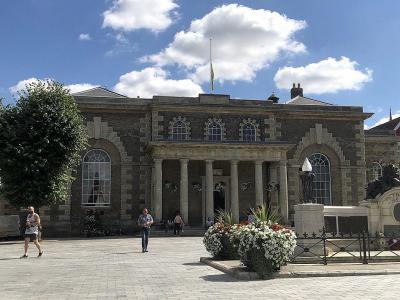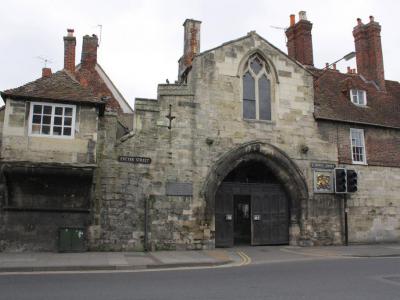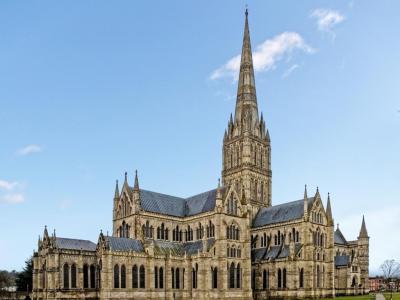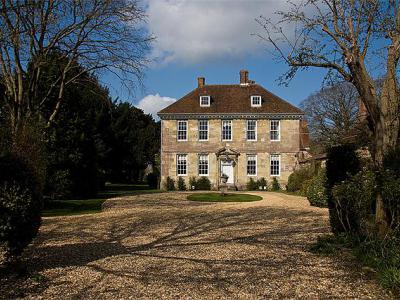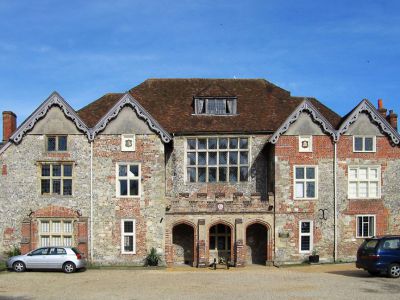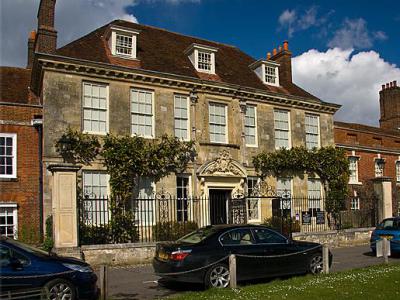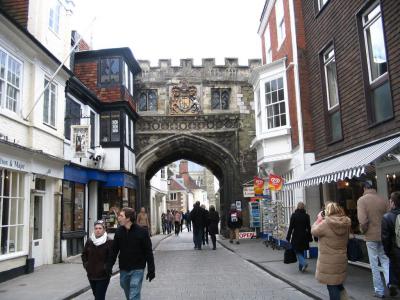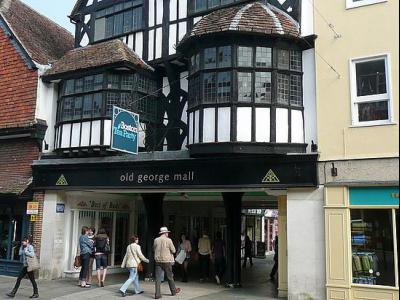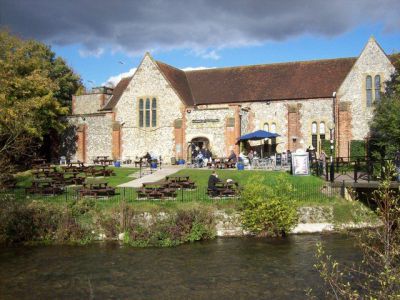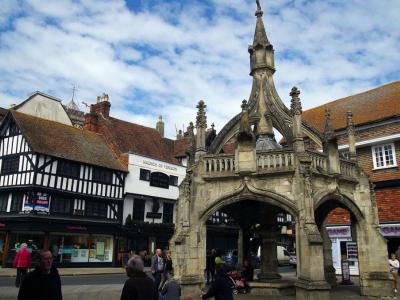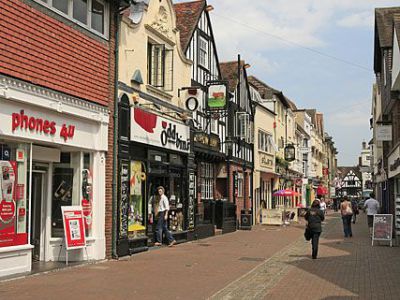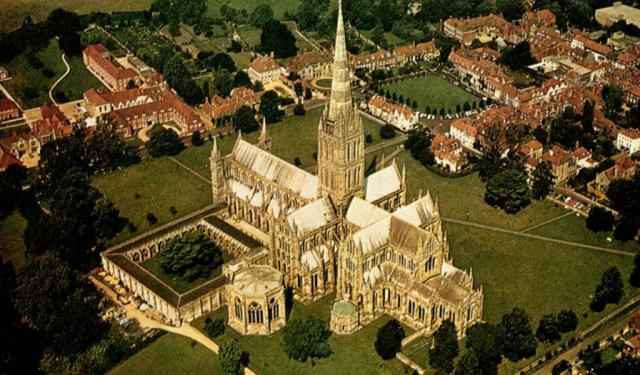
Salisbury Introduction Walking Tour (Self Guided), Salisbury
Old Sarum is not as old as neighboring Stonehenge, but it is old. A hill fort occupied the site as early as 300 BC. The ubiquitous Romans did not overly attend to it but it fell to Saxon King Cynric of Wessex in 552 AD. Danes and Norwegians invaded frequently enough until 1066, when William of Normandy settled matters among the parties.
A motte-and-bailey castle was established at the confluence of the rivers Bourne and Avon in 1070. Herman of Flanders and Saint Osmund, bishop of Salisbury, began construction of the first Salisbury Cathedral at Old Sarum. Bishop Richard Poore moved the diocese in 1220 to a new town on his estate by the rivers Nadder and Avon.
The new town was called "New Sarum" or "Sarisberias." Work on the present Salisbury Cathedral began in 1221. It was finished in 38 years, a building record for a cathedral. The 404 foot cathedral spire, built later, dominates the Salisbury skyline today. The cathedral is a perfect example of Early English Gothic construction.
The cathedral is bounded by walls in an eighty-acre Close with five gates. Within the Close are houses dating from 1200 to the 1900s. Among them are the Chapter House, home to the Magna Carta, Arundells, the Mompesson House, the Rifles Museum and Sir Christopher Wren's Sarum College. The Salisbury Museum is in the 13th century King's House.
The Walton Canonry was leased to artist Rex Whistler. John Constable painted here in 1820. Leave the close via the Harnham Gate, stand on the Ayleswade Bridge and enjoy the view of the River Avon. Visit the De Vaux House on St Nicholas Road. There is a welcoming tea garden next to the Salisbury Museum and cafes around the area.
In the town Market Square there are market days on Tuesdays and Thursdays. There are often street festivals. The square and connecting medieval streets are teeming with shoppers and people enjoying the pubs and cafes. Explore the close, Stonehenge, Elizabeth II Gardens. But the best thing might be to roam the streets and go "local."
A motte-and-bailey castle was established at the confluence of the rivers Bourne and Avon in 1070. Herman of Flanders and Saint Osmund, bishop of Salisbury, began construction of the first Salisbury Cathedral at Old Sarum. Bishop Richard Poore moved the diocese in 1220 to a new town on his estate by the rivers Nadder and Avon.
The new town was called "New Sarum" or "Sarisberias." Work on the present Salisbury Cathedral began in 1221. It was finished in 38 years, a building record for a cathedral. The 404 foot cathedral spire, built later, dominates the Salisbury skyline today. The cathedral is a perfect example of Early English Gothic construction.
The cathedral is bounded by walls in an eighty-acre Close with five gates. Within the Close are houses dating from 1200 to the 1900s. Among them are the Chapter House, home to the Magna Carta, Arundells, the Mompesson House, the Rifles Museum and Sir Christopher Wren's Sarum College. The Salisbury Museum is in the 13th century King's House.
The Walton Canonry was leased to artist Rex Whistler. John Constable painted here in 1820. Leave the close via the Harnham Gate, stand on the Ayleswade Bridge and enjoy the view of the River Avon. Visit the De Vaux House on St Nicholas Road. There is a welcoming tea garden next to the Salisbury Museum and cafes around the area.
In the town Market Square there are market days on Tuesdays and Thursdays. There are often street festivals. The square and connecting medieval streets are teeming with shoppers and people enjoying the pubs and cafes. Explore the close, Stonehenge, Elizabeth II Gardens. But the best thing might be to roam the streets and go "local."
How it works: Download the app "GPSmyCity: Walks in 1K+ Cities" from Apple App Store or Google Play Store to your mobile phone or tablet. The app turns your mobile device into a personal tour guide and its built-in GPS navigation functions guide you from one tour stop to next. The app works offline, so no data plan is needed when traveling abroad.
Salisbury Introduction Walking Tour Map
Guide Name: Salisbury Introduction Walking Tour
Guide Location: England » Salisbury (See other walking tours in Salisbury)
Guide Type: Self-guided Walking Tour (Sightseeing)
# of Attractions: 11
Tour Duration: 1 Hour(s)
Travel Distance: 1.7 Km or 1.1 Miles
Author: Sandra
Sight(s) Featured in This Guide:
Guide Location: England » Salisbury (See other walking tours in Salisbury)
Guide Type: Self-guided Walking Tour (Sightseeing)
# of Attractions: 11
Tour Duration: 1 Hour(s)
Travel Distance: 1.7 Km or 1.1 Miles
Author: Sandra
Sight(s) Featured in This Guide:
- Market Square and Guildhall
- St. Ann Gate & Cathedral Close Walls
- Salisbury Cathedral
- Arundells
- The Rifles (Berkshire & Wiltshire) Museum
- Mompesson House
- High Street Gate
- Old George Inn & Mall
- The Bishop’s Mill
- Poultry Cross
- Bucher Row
1) Market Square and Guildhall
Tuesday, the time is past midday, year 1219. Tuesday was better for older customers in the Market Square. The pace was more leisurely. Saturday was the busier day. Flash forward, it's Tuesday again, same time. The year is 2019. Tuesdays and Saturdays are still market days in Salisbury. Eight hundred years of Tuesdays and Saturdays.
Shopping days were formally proclaimed to be Tuesdays and Saturdays in 1361. The medieval market often spread to surrounding streets. Market stalls were grouped by the goods sold. Streets were called Fish Row, Silver Street, Oatmeal Row, Ox Row, and Butchers Row. Then as today, one might get anything at the Salisbury market.
In 1314 the "Bishop's Guildhall", built for Simon of Ghent, Bishop of Salisbury, was established on the Market Square. In 1585 the Council House of the Merchants Guild was erected next to the Guildhall. The Council House burned down after a banquet (a memorable party!) in 1780. In 1785 the old Guild hall was demolished and replaced.
The present building was designed by architects Robert Taylao and William Pilkington. The building has a portico with Doric columns surmounted by a triglyph frieze. There are tall window arches flanking the portico. The hall is the meeting place of the Salisbury City Council.
The main room at the Hall is the banqueting hall. Visitors have included King George III, Lord Nelson, Princess Diana, and Queen Elizabeth II.
Shopping days were formally proclaimed to be Tuesdays and Saturdays in 1361. The medieval market often spread to surrounding streets. Market stalls were grouped by the goods sold. Streets were called Fish Row, Silver Street, Oatmeal Row, Ox Row, and Butchers Row. Then as today, one might get anything at the Salisbury market.
In 1314 the "Bishop's Guildhall", built for Simon of Ghent, Bishop of Salisbury, was established on the Market Square. In 1585 the Council House of the Merchants Guild was erected next to the Guildhall. The Council House burned down after a banquet (a memorable party!) in 1780. In 1785 the old Guild hall was demolished and replaced.
The present building was designed by architects Robert Taylao and William Pilkington. The building has a portico with Doric columns surmounted by a triglyph frieze. There are tall window arches flanking the portico. The hall is the meeting place of the Salisbury City Council.
The main room at the Hall is the banqueting hall. Visitors have included King George III, Lord Nelson, Princess Diana, and Queen Elizabeth II.
2) St. Ann Gate & Cathedral Close Walls (must see)
St Annes Gate is one of the entrances to the Close of Salisbury Cathedral, the biggest close in England. The gate was built around 1331. It all came about in this fashion. In 1219, Bishop Richard Poore got the go-ahead from both the Pope and the King of England to build a new church. He chose the site of Salisbury today. He called it "New Sarum."
The legend goes the bishop shot an arrow over the River Avon and killed a deer. He decided to build where the deer fell. That's the legend. The fact is he wanted to have a diocese of his own. He laid out a grid pattern. In 1327 Edward III authorized an "embattled wall of stone" around the Close of the Cathedral to protect the clergy.
The walls of the Close were built using stones salvaged from the deserted Cathedral at Old Sarum. St Anne's Gate was also built using these stones. It is two stories high with a central stone arch. On the upper floor over the archway is a chapel lighted by pointed arched trifora windows on the east and west sides.
Next door to the Gate is the Malmesbury house. King Charles II stayed here I 1665. He was on the run from the Plague in London. He was fond of speechifying from his window. The chapel above the gateway was dedicated to St Anne and the Virgin Mary. After the Reformation, it was a music room. The great German-British composer George Handel gave his first concert in England here.
The legend goes the bishop shot an arrow over the River Avon and killed a deer. He decided to build where the deer fell. That's the legend. The fact is he wanted to have a diocese of his own. He laid out a grid pattern. In 1327 Edward III authorized an "embattled wall of stone" around the Close of the Cathedral to protect the clergy.
The walls of the Close were built using stones salvaged from the deserted Cathedral at Old Sarum. St Anne's Gate was also built using these stones. It is two stories high with a central stone arch. On the upper floor over the archway is a chapel lighted by pointed arched trifora windows on the east and west sides.
Next door to the Gate is the Malmesbury house. King Charles II stayed here I 1665. He was on the run from the Plague in London. He was fond of speechifying from his window. The chapel above the gateway was dedicated to St Anne and the Virgin Mary. After the Reformation, it was a music room. The great German-British composer George Handel gave his first concert in England here.
3) Salisbury Cathedral (must see)
The name "Salisbury" is derived from the name "Sarum." The Salisbury of today started out as New Sarum. The story of Salisbury Cathedral began in Old Sarum. Things were not happy in Old Sarum. The clergy and the military were forever at odds over Sarum Cathedral. Richard Poore, bishop, decided to relocate the bishopric to New Sarum.
It is said the bishop, Moore, shot an arrow. The arrow killed a deer. Where the deer fell would be the site of the new cathedral. Another myth claimed that the cathedral, Old Sarum, and Stonehenge were mystically aligned. It is more likely that the marshy ground was chosen because a more desirable site could not be had.
The cathedral was designed by architect and master stonemason Elias of Dereham. Elias had been at Runnymede in 1215 when King John signed the Magna Carta. Elias made copies. He would install one of them in the Cathedral chapter house. It is there today. The formal name of the cathedral is the Cathedral Church of the Blessed Virgin Mary.
The foundation was laid in 1220. The nave, transepts, and choir were finished by 1258. This was record time for cathedral building. The cloisters were done by 1240, the chapter house in 1263 and the tower and spire by 1320. The 404 foot spire is the tallest in England. The cathedral was built in one style only, Early English Gothic.
The west facade is a screen type. It has a turret at each end. There are two buttresses in the center supporting the triple center window. The center is capped with a gable holding four lancet windows under two quatrefoil windows and a mandorla framing an image of Christ in Majesty. There are 73 of 130 niches which contain statues.
The interior has a high narrow nave. It has a pointed arcade, a gallery and clerestory. The walls are of grey stone and the columns are of dark marble. Tombs of royal families lie between the columns. A large cruciform font by sculptor William Pie was installed in 2008. A statue of Richard Moore on the facade holds a model of the cathedral.
It is said the bishop, Moore, shot an arrow. The arrow killed a deer. Where the deer fell would be the site of the new cathedral. Another myth claimed that the cathedral, Old Sarum, and Stonehenge were mystically aligned. It is more likely that the marshy ground was chosen because a more desirable site could not be had.
The cathedral was designed by architect and master stonemason Elias of Dereham. Elias had been at Runnymede in 1215 when King John signed the Magna Carta. Elias made copies. He would install one of them in the Cathedral chapter house. It is there today. The formal name of the cathedral is the Cathedral Church of the Blessed Virgin Mary.
The foundation was laid in 1220. The nave, transepts, and choir were finished by 1258. This was record time for cathedral building. The cloisters were done by 1240, the chapter house in 1263 and the tower and spire by 1320. The 404 foot spire is the tallest in England. The cathedral was built in one style only, Early English Gothic.
The west facade is a screen type. It has a turret at each end. There are two buttresses in the center supporting the triple center window. The center is capped with a gable holding four lancet windows under two quatrefoil windows and a mandorla framing an image of Christ in Majesty. There are 73 of 130 niches which contain statues.
The interior has a high narrow nave. It has a pointed arcade, a gallery and clerestory. The walls are of grey stone and the columns are of dark marble. Tombs of royal families lie between the columns. A large cruciform font by sculptor William Pie was installed in 2008. A statue of Richard Moore on the facade holds a model of the cathedral.
4) Arundells (must see)
In the Close of Salisbury Cathedral is the Queen Anne house, "Arundells." The earliest recorded resident was Henry of Blunston, Archdeacon of Dorset. He resided there from 1291 to 1316. One resident, Father Leonard Bilson, was imprisoned for witchcraft in 1561.
Sir Richard Mompesson leased Arundells in 1609. His family later built neighboring Mompesson House. John Wyndham took residence in 1718. His daughter, Ann, married James Everard Arundel, and that is how Arundells came to be. By then England had become a Protestant country. James was staunchly Catholic. He would hide catholic priests in the attic.
Arundells was the site of the Godolphin Girls School from 1839 to 1844. It was later a boys boarding school. In World War II the house was a wool depot and library. After the war, demolition was contemplated but the house was saved by Mr. and Mrs. Robert Hawkings in 1964. The house was renovated and sold to Sir Edward Heath in 1985.
Sir Edward had the interior redesigned by Derek Frost. Frost modernized the house and designed furniture, including cabinets to house Sir Edward's sailing trophies and art awards. Heath bought the property in 1993. He died in 2005.
Arundells is open to the public five days a week from March to November. It is closed on Wednesdays and Thursdays. The house also is a venue for private events, recitals and conferences.
Sir Richard Mompesson leased Arundells in 1609. His family later built neighboring Mompesson House. John Wyndham took residence in 1718. His daughter, Ann, married James Everard Arundel, and that is how Arundells came to be. By then England had become a Protestant country. James was staunchly Catholic. He would hide catholic priests in the attic.
Arundells was the site of the Godolphin Girls School from 1839 to 1844. It was later a boys boarding school. In World War II the house was a wool depot and library. After the war, demolition was contemplated but the house was saved by Mr. and Mrs. Robert Hawkings in 1964. The house was renovated and sold to Sir Edward Heath in 1985.
Sir Edward had the interior redesigned by Derek Frost. Frost modernized the house and designed furniture, including cabinets to house Sir Edward's sailing trophies and art awards. Heath bought the property in 1993. He died in 2005.
Arundells is open to the public five days a week from March to November. It is closed on Wednesdays and Thursdays. The house also is a venue for private events, recitals and conferences.
5) The Rifles (Berkshire & Wiltshire) Museum
The Rifles Berkshire and Wiltshire Museum is housed in a listed building called "The Wardrobe." The original building was erected in 1254. It was rebuilt in the 15th century. It was used primarily to store the robes and sacerdotals of the Bishop of Salisbury. Museum trustees acquired the Wardrobe from the cathedral Dean in 1981.
The building has a symmetrical east facade. It has two stories and an attic. It is made from flint and stone rubble with a tile roof. The center has a large casement window between the wings. A triple Tudor arched arcade frames the entrance. Since James I and Queen Ann were guests here, the Wardrobe has been called "the King's House."
The museum is within the Cathedral Close. It holds collections of military artifacts from the Royal Berkshire regiment and the Wiltshire Regiment. The museum was opened by the Duke of Edinburgh in July of 1982. It was given the nickname of "Redcoats in the Wardrobe." The museum presently has 34,000 articles, of which 1,200 are on display.
There are 16,000 photos, 6,000 documents, and 4,000 medals. The artifacts are swords, rifles, pistols, ant-tank weapons, flags and battlefield souvenirs, including one cannon ball from the American Revolution. Four rooms use a timeline approach from the late 18th century to Afghanistan.
The museum is open from February to December, Monday through Saturday, 10 am to 5 pm.
The building has a symmetrical east facade. It has two stories and an attic. It is made from flint and stone rubble with a tile roof. The center has a large casement window between the wings. A triple Tudor arched arcade frames the entrance. Since James I and Queen Ann were guests here, the Wardrobe has been called "the King's House."
The museum is within the Cathedral Close. It holds collections of military artifacts from the Royal Berkshire regiment and the Wiltshire Regiment. The museum was opened by the Duke of Edinburgh in July of 1982. It was given the nickname of "Redcoats in the Wardrobe." The museum presently has 34,000 articles, of which 1,200 are on display.
There are 16,000 photos, 6,000 documents, and 4,000 medals. The artifacts are swords, rifles, pistols, ant-tank weapons, flags and battlefield souvenirs, including one cannon ball from the American Revolution. Four rooms use a timeline approach from the late 18th century to Afghanistan.
The museum is open from February to December, Monday through Saturday, 10 am to 5 pm.
6) Mompesson House (must see)
The Mompesson House is an 18th century Queen Anne style house located within the Cathedral Close at Salisbury. It is owned by the National Trust since 1975. it was built for Sir Thomas Mompesson MP, in 1679. He was a member of Parliament from 1661 to 1689 for Wilton, Salisbury, Wiltshire and the rotten borough of Old Sarum.
The house has Chilmark stone facing. Next to the house is a brick service building that replaced the old Eagle inn that was closed in 1625. Thomas' son, Charles, completed the service building in 1701, leaving his initials on the tops of the drain pipes.
The house passed sequentially to other families until 1846. In that year the Townsend family moved in. Miss Barbara Townsend, a dashing, well known artist, lived there all her life, until 1942. The house was purchased by architect Denis Martineau. Denis left the house to the National Trust in 1971.
The house is currently used to show the Turnbull collection of English glassware and the Bessemer-Wright collection of ceramics. The house was featured in the 1995 version of the film, "Sense and Sensibility."
The house has Chilmark stone facing. Next to the house is a brick service building that replaced the old Eagle inn that was closed in 1625. Thomas' son, Charles, completed the service building in 1701, leaving his initials on the tops of the drain pipes.
The house passed sequentially to other families until 1846. In that year the Townsend family moved in. Miss Barbara Townsend, a dashing, well known artist, lived there all her life, until 1942. The house was purchased by architect Denis Martineau. Denis left the house to the National Trust in 1971.
The house is currently used to show the Turnbull collection of English glassware and the Bessemer-Wright collection of ceramics. The house was featured in the 1995 version of the film, "Sense and Sensibility."
7) High Street Gate
One of the five entries in Salisbury’s old city wall (including 14th-century St Ann’s Gate, Queen’s Gate and St Nicholas’s Gate, as well as Wordsworth School Gate built in the 19th century), High Street Gate is the main entrance to Salisbury's Cathedral Close and, once was, a key access point to the rest of the city.
As its name suggests, the gate is located on High Street; its other name is the North Gate. The structure was built somewhere between 1327 and 1342, using a mix of rubble stone and ashlar, and originally housed a small lock-up jail for those convicted of crimes within the Liberty of the Close. The gate was designed mostly for pedestrian traffic, more common in those days, rather than as a carriageway (especially now, it proves a bit too tight for contemporary vehicles).
Over the course of centuries the High Street Gate underwent several modifications, with a portcullis added and then removed, windows and a staircase (leading to an upper room flanking the carriageway on the one side) added in the late 15th century, a new roof (replaced in 1901) and a door added to the nearby Porter's Lodge in the 17th century. The lodge housed the Close porter, a much sought-after sinecure for the servants of kings and nobles in the Middle Ages.
The gatehouse was used as an office of the Cathedral clerk of works in 1950 and is still in use as an office. The buildings on either side were originally shops and houses for lay vicars; most of them are now private homes.
On the town side of the gate is the Stuart royal coat of arms, added in the 17th century, and on the other side is a statue of Edward VII, which was put there in 1902.
The gate is locked at 11 pm and opens again at 6 am.
As its name suggests, the gate is located on High Street; its other name is the North Gate. The structure was built somewhere between 1327 and 1342, using a mix of rubble stone and ashlar, and originally housed a small lock-up jail for those convicted of crimes within the Liberty of the Close. The gate was designed mostly for pedestrian traffic, more common in those days, rather than as a carriageway (especially now, it proves a bit too tight for contemporary vehicles).
Over the course of centuries the High Street Gate underwent several modifications, with a portcullis added and then removed, windows and a staircase (leading to an upper room flanking the carriageway on the one side) added in the late 15th century, a new roof (replaced in 1901) and a door added to the nearby Porter's Lodge in the 17th century. The lodge housed the Close porter, a much sought-after sinecure for the servants of kings and nobles in the Middle Ages.
The gatehouse was used as an office of the Cathedral clerk of works in 1950 and is still in use as an office. The buildings on either side were originally shops and houses for lay vicars; most of them are now private homes.
On the town side of the gate is the Stuart royal coat of arms, added in the 17th century, and on the other side is a statue of Edward VII, which was put there in 1902.
The gate is locked at 11 pm and opens again at 6 am.
8) Old George Inn & Mall
The Old George Inn on High Street was built as a "coaching" inn, in 1364. The Inn was named for its association with the Guild of Saint George. The Guild was formed in 1306 by the mayor and corporation of the city.
In 1645 Oliver Cromwell spent the night at the Inn on his way to meet his army. Samuel Pepys, diarist and "Father of the British Navy", wrote of the Inn, "very good diet, but very dear." He had a row with the landlady and moved to cheaper digs next day.
Inside the Old George is a warren of hallways, warped floors and steep, uneven stairs. A fire door from the mall opens on the Inn banqueting hall. Wooden pillars and beams frame a minstrel's gallery and a Jacobean mantelpiece.
Overhead are the carved heads of King Edward II and Queen Isabella. Isabella is said to have murdered the king. But here they are, together again. Charles Dickens refers to the Inn in "Martin Chuzzelwit." William Shakespeare and company rehearsed "As You Like It" on the mall. The 14th century inn contrasts sharply with the style of the mall.
The Mall is home to many high-profile shops and stores, including: Marks & Spencer, WH Smith, and H&M. There is an onsite shoppers' car park on New Street with access to the Mall. There are cafes within the Mall including: Pret a Manger, Costa Coffee and Cafe Rouge. After the Cathedral Close, take a walk to the Mall for a coffee/shopping break.
In 1645 Oliver Cromwell spent the night at the Inn on his way to meet his army. Samuel Pepys, diarist and "Father of the British Navy", wrote of the Inn, "very good diet, but very dear." He had a row with the landlady and moved to cheaper digs next day.
Inside the Old George is a warren of hallways, warped floors and steep, uneven stairs. A fire door from the mall opens on the Inn banqueting hall. Wooden pillars and beams frame a minstrel's gallery and a Jacobean mantelpiece.
Overhead are the carved heads of King Edward II and Queen Isabella. Isabella is said to have murdered the king. But here they are, together again. Charles Dickens refers to the Inn in "Martin Chuzzelwit." William Shakespeare and company rehearsed "As You Like It" on the mall. The 14th century inn contrasts sharply with the style of the mall.
The Mall is home to many high-profile shops and stores, including: Marks & Spencer, WH Smith, and H&M. There is an onsite shoppers' car park on New Street with access to the Mall. There are cafes within the Mall including: Pret a Manger, Costa Coffee and Cafe Rouge. After the Cathedral Close, take a walk to the Mall for a coffee/shopping break.
9) The Bishop’s Mill
The Bishop's Mill is no longer a mill. It is a pub in an historic building located on an island in the River Avon in the center of Salisbury. The facade is dressed with flint and stone. It has two gables with stone mullioned tall windows. It has three stories of red brick and wooden casements. The roof has old tiles.
The earliest lease for the property is dated 1504. The lease describes the property as "four water mills" called the Bishops Mills. The pub was in fact owned by the bishop of Old Sarum and it is mentioned in William the Conqueror's Doomsday Book.
The Bishops Mill pub has a covered beer garden with tables and chairs set on a lawn alongside the serene avon River. A wooden bridge reaches across the river to the mill. The inside is a a high-ceiling main space. The walls are of flint and brick and there is a mezzanine type second floor gallery. The mill is a favorite watering hole for both tourists and locals.
The earliest lease for the property is dated 1504. The lease describes the property as "four water mills" called the Bishops Mills. The pub was in fact owned by the bishop of Old Sarum and it is mentioned in William the Conqueror's Doomsday Book.
The Bishops Mill pub has a covered beer garden with tables and chairs set on a lawn alongside the serene avon River. A wooden bridge reaches across the river to the mill. The inside is a a high-ceiling main space. The walls are of flint and brick and there is a mezzanine type second floor gallery. The mill is a favorite watering hole for both tourists and locals.
10) Poultry Cross
Poultry Cross is an ornate Gothic stone market cross in Salisbury. It was built in the 14th century and modified in the 18th century. It stands at the intersection of Silver Street and Minster Street. There were once four such crosses in Salisbury. Poultry Cross is the only one left.
The crosses of the past are Cheese Cross in the Cheese Market, Bernard's Cross for livestock and a wool and yarn cross in the Market Square. The current stone structure of Poultry Cross was built in the 15th century. It originally had flying buttresses. These were removed in 1711. The buttresses of today were installed in 1854.
The Poultry cross was originally used to sell birds. Today it is a handy rain shelter which is also used for market stalls twice a week, on Tuesdays and Saturdays. It is also handy for people-watching while taking a shopping break. The birds are gone but not forgotten.
The crosses of the past are Cheese Cross in the Cheese Market, Bernard's Cross for livestock and a wool and yarn cross in the Market Square. The current stone structure of Poultry Cross was built in the 15th century. It originally had flying buttresses. These were removed in 1711. The buttresses of today were installed in 1854.
The Poultry cross was originally used to sell birds. Today it is a handy rain shelter which is also used for market stalls twice a week, on Tuesdays and Saturdays. It is also handy for people-watching while taking a shopping break. The birds are gone but not forgotten.
11) Bucher Row
Two rows in the Market Square are called Butcher Row and Ox row. Butcher Row is first mentioned in the early 14th century. By 1455 it was mostly shops but it did contain the residence of John Chippenham, first warden of the Butchers' Guild. City butchers occupied permanent sites on the Row. Out-of-town butchers set up stalls on Ox Row.
The open space behind Butchers Row was the place in the early 15th century for butchers to kill their beasts (no refrigeration in those days). Today the row is a pedestrianized area (no killing ground). The shops are individually owned, small businesses.
There is Hawkins Bazaar, a toy shop (no live or dead animals), Fat Face offers many alternative clothing styles for men and women. A shop called tReds sells trendy footwear. Mobile phones are represented by Phones 4U and Goldsmiths has jewelry (of course!). Tired already? Take a break at Costa Coffee, Stobys or Reeve the Baker. They can help.
The open space behind Butchers Row was the place in the early 15th century for butchers to kill their beasts (no refrigeration in those days). Today the row is a pedestrianized area (no killing ground). The shops are individually owned, small businesses.
There is Hawkins Bazaar, a toy shop (no live or dead animals), Fat Face offers many alternative clothing styles for men and women. A shop called tReds sells trendy footwear. Mobile phones are represented by Phones 4U and Goldsmiths has jewelry (of course!). Tired already? Take a break at Costa Coffee, Stobys or Reeve the Baker. They can help.
Walking Tours in Salisbury, England
Create Your Own Walk in Salisbury
Creating your own self-guided walk in Salisbury is easy and fun. Choose the city attractions that you want to see and a walk route map will be created just for you. You can even set your hotel as the start point of the walk.
Historical Houses Tour
Founded more than 800 years ago, Salisbury understandably has a great number of historical, architectural, and cultural gems worthy of a visit. The medieval houses, churches, inns, and hospitals blend harmoniously with the modern sites of the city.
Your exploration of these treasures can be started at Trinity Hospital, a picturesque almshouse founded in the 14th century, offering a glimpse... view more
Tour Duration: 1 Hour(s)
Travel Distance: 1.5 Km or 0.9 Miles
Your exploration of these treasures can be started at Trinity Hospital, a picturesque almshouse founded in the 14th century, offering a glimpse... view more
Tour Duration: 1 Hour(s)
Travel Distance: 1.5 Km or 0.9 Miles
Cathedral Close Tour
Salisbury Cathedral, apart from being renowned as the holder of Britain’s tallest spire, the world’s best preserved original copy of Magna Carta (1215) and Europe’s oldest working clock, is also famous for its Close, the largest in the country, measuring 80 acres (or 32 hectares).
The areas surrounding cathedrals' grounds, sometimes extending for hundreds of meters from the main... view more
Tour Duration: 1 Hour(s)
Travel Distance: 1.2 Km or 0.7 Miles
The areas surrounding cathedrals' grounds, sometimes extending for hundreds of meters from the main... view more
Tour Duration: 1 Hour(s)
Travel Distance: 1.2 Km or 0.7 Miles
The Most Popular Cities
/ view all
